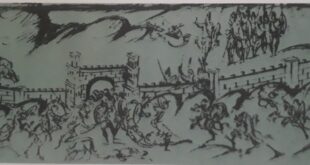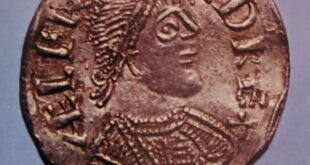The birth of Hungary
The battle of the Lechfeld, which was so important to Western Europe, had an equally profound influence on events in Central and Eastern Europe. The almost total annihilation of their army compelled the Magyars to settle in their new home on the Hungarian plains and within sixty years they had embraced Christianity. Under King Stephen I (997-1038) , who was later canonized, they accepted Christianity from Rome, a process that had been began by Stephen’s father, Duke Geza. The new king accepted not only religion but also his royal title and crown from Pope Sylvester II. Although he had to face opposition from some of his pagan nobility, he was able to push through his religious programs and also to lay the basis of a royal administration closely modelled on that of the German empire. During the eleventh century the new kingdom, halted in its westward advance, also lost part of its territory in the southeast to the nomadic Patzinaks. This loss was balanced for a time by the Hungarian conquest, which gave the new state an important seacoast on the Adriatic.
Thus in the early eleventh century, the main contours of medieval Europe had emerged and the political position of the German emperors seemed assured.
Sung Dynasty, China
The empire of Otto and his Saxon successors was roughly contemporary with a renewed period of grandeur and prosperity in the world’s largest empire, China. We have seen how in the late ninth century the glories of the Wang dynasty were subject to internal divisions and attacks over the frontiers by Asian barbarians. After the deposition of the last T’ang emperor in 907, there followed the fifty-year period generally known as the age of the Five Dynasties. The largest single territory was that in the north, which was subject to the fluctuating rivalries of shortlived emperors — some remotely related to the T’ang, others of barbarian extraction. In fact, the true inheritors and preservers of the T’ang civilization were large states to the south — states that had already begun to assert their independence in the last years of the ninth century — for the most part well ordered and free of internal or external strife. In the north, this period saw the surrender of a large stretch of territory between the Great Wall and Peking to the nomad tribes of the Kitans. This surrender was to be confirmed by the consolidating and peacefully intentioned Sung dynasty. The area was not recovered for another three centuries, when the whole of China came under the rule of the Mongols.

The Sung dynasty, regarded by some as the most enlightened age of Chinese history, was founded at a time when the Chinese were fully conscious of their national identity, one based on a common written language, an old tradition that the lands of the Middle Kingdom should be governed by no more than one head and by an administration with a common training and a common devotion to the religious and philosophical teachings known as Confucianism. The turmoil of the Five Dynasties was generally felt to be an unwarranted disturbance of the natural and proper order of things. The Sung came to power through a coup d état, but the first Sung emperor, Chao Kuang-yin, was a man of unusual stamp. Such was the force and moderation of his character, that he was able to prevent the massacre of the deposed imperial family. Further, to free himself of the threat of a military coup, he awarded large estates, remote from the capital to the chief commanders of his own army, who in exchange, resigned their commands. He then set about restoring the civil administration. Thus began a period marked throughout by moderation and a remarkable concern on the part of a line of outstanding emperors for the arts of government. Within thirty years, the rulers of the southern states had accepted, with comparatively little opposition, the new dynasty. The eleventh century was to be one of the golden ages of Chinese history.
Buddhism
Ruled by an imperial house, whose main concern was the maintenance of peace and the efficient administration of the empire’s immense resources, China was free from the rebellions and threat of rebellions that had been all too common under the dynamic yet oppressive rule of the T’ang. The period was one of renewed study of the Chinese classics and also, of an attempt to integrate foreign systems, such as Indian Buddhism, into a single all-embracing universal system based on a radically rethought Confucianism. The advance of scholarship was greatly facilitated by the fact, that even under the Five Dynasties, the classics had been printed for the first time; their resulting diffusion and availability, produced an intensity of commentary and study, that may be reasonably compared with the impact of the printing of the Christian texts, on the age of the sixteenth-century Reformation in Europe.
After an abortive attempt to expel the Kitans in the first years of the eleventh century, the third emperor of the Sung dynasty accepted the situation and agreed to pay a large annual subsidy to those nomadic invaders. The outcome was a century of peace for the Chinese and a century of exposure to civilization for the Kitans themselves. In an age when the settled populations of the Far East were always liable to the depredations of more barbaric and aggressive neighbours, the Kitans were to suffer the fate of the Chinese themselves and fall to the armies of their former subjects, the hardy tribes of the Kin or Chin, the “golden people”. Sung China failed to appreciate the gravity of this new threat and as a result, still larger territories to the north were lost.

Golden Age of the Sung Dynasty
Yet despite its reduced state, China, thanks largely to the pacific policies of the Sung emperors, was able to boast a population far in excess of its predecessors and of course far larger than anything beyond its frontiers. It has been estimated, on the basis of the contemporary imperial census of families, that in 1124 the population of China was already at the 100,000,000 mark. The prosperity of the empire was due, both to the long period of internal peace and also to the enlightened policies of its rulers.
Wang An-shih, the finance minister of the Emperor Shen Tsung (1068-85), believed that the wealth of the Chinese empire derived from the peasants; he aimed at lessening the tribute owed by the provinces to the capital, substituting money taxes for labour obligations and thus weakening the hold of the money lenders.
The “New Laws” were certainly not aimed at social justice, but rather at introducing greater effciency and flexibility into the administration of imperial finances. Wang An-shih belonged to the party of the Innovators; and the political struggles between them and their opponents, the Conservatives, contributed to the weakening of the empire and hastened its capitulation to the Kin. The eventual triumph of the Conservatives, who rested their policy on strict conformity to the precepts of Confucianism and the continuance of the practices of the past, was to colour all aspects of Chinese civilization. It certainly mitigated against originality of expression in the established arts, such as bronzeworking. However, in the relatively new art of porcelain, not discovered until the eighth century, artists enjoyed comparative freedom and Sung porcelain is generally regarded not only as the first, but also as the finest produced in China.

The Viking World
The explorations of Eric the Red, remarkable as they were, are only a part of the story of Viking conquest and exploration. The raiders from the sea were a fearful and bloody terror to the sedentary populations of Europe, from Scotland to the Mediterranean. The predatory attacks of the Vikings seemed to threaten the new civilization rising from the Dark Ages with utter destruction. The sack of the Holy Island of Lindisfarne off the northeast coast of England in 793 presaged the storm. Adventurers from Denmark and Norway set up kingdoms in Ireland and Man, won control of most of the northern and eastern parts of England, established themselves in northern France, raided in the Mediterranean and carved a kingdom for themselves in southern Italy.
For centuries, the Scandinavian peoples had been in trading contact with the Roman world and one of the most important of their routes, led down the rivers of European Russia to Byzantium. The famous Varangian Guard of the Eastern Emperors, in fact, was recruited from Norse adventurers. In the ninth century, Swedish leaders set up a number of “Varangian” principalities, chief of which were Kiev and Novgorod. Under the semi-legendary Rurig of Novgorod and Igor of Kiev, the traffic in luxury goods – going north, slaves and fur going south – flourished and the new states rapidly increased in wealth and power. By the end of the ninth centur,y they had been united under the princes of Kiev and with the defeat of the Magyars and the Patzinak Turks, the supremacy of the Varangian-Slav principality of Kiev was assured from the Black Sea to the Baltic.
Civilizing Influence
Despite their well-earned reputation for brutality and vandalism abroad, the Scandinavians had developed a vigorous and confident tradition of their own. They produced, for instance, a unique and extremely beautiful style of animal carving and some of the world’s finest masterpieces of the metal workers’ art on their weapons and ships. The ship was central to Viking life; it was not only a mode of transport but also played an important part in the rituals of the dead and the afterlife belief systems. To a later age, it is the breathtaking beauty of the lines of these long, rakish yet supremely elegant vessels that catches the imagination. Perfectly adapted to their function of sea voyages followed by periods of river navigation, the Viking ships are in themselves proof of the artistic and engineering skill of this wild, terrible but talented people.

The Scandinavian kingdoms
The Vikings were distinguished from the first wave of Germanic invaders of the fifth century, by the rapidity with which they became assimilated with the conquered peoples. In Normandy, Norman England and Sicily the same pattern is seen; and in vast areas of Slavic Russia, the adept and probably not very numerous conquerors had soon merged into their surroundings. Barely a century after the arrival of the first Varangian or Swedish princes, the Russian states accepted Christianity. Their leader, Grand Prince Vladimir of Kiev, was in effect a Slav.
Yet the heroic epic of exploration, rapine and conquest, in addition to peaceful trading, which even took the Vikings to the confines of Persia, should not blind us to the evolution of the Scandinavian kingdoms themselves. Under Harold Bluetooth (d. 985), Denmark was already a Christian kingdom. Although there was a short period when Denmark reverted to paganism under his son and successor, Sweyn, the great Canute not only restored the religion, but also confirmed earlier conquests. He ruled over an empire that comprised England, Norway and Denmark itself.
The empire fell apart after Canute’s death, but his successors were able to assert their independence from their great southern neighbour, the German empire. With the reign of Waldemar, Denmark achieved the frontiers she was to maintain for the rest of the Middle Ages, the southern provinces of Sweden and large tracts along the Baltic coast. Waldemar used the power of the Church to consolidate his rule, finding in Archbishop Absalom an able and willing right-hand man.
At about the same time, St. Eric IX of Sweden, was using the pretext of holy war to conquer the territory of the pagan Finns on his eastern frontier. The first of the Scandinavian countries to achieve a degree of unity was Norway, under Harold Fairhair (d. 933). His successful campaigns against the petty kings of the time led many to flee Norway for Iceland, but the history of the country after his time remained troubled. Many attempts were made to establish Christianity on a firm footing, but it was not until the eleventh century that solid progress was made.
In this period, too, Christianity became the dominant faith in Iceland, although the country had already been settled by Irish monks, themselves driven out by the ninth century refugees from Harold I’s Norway. In the year 930, the oldest surviving European parliament, the Icelandic Althing, was established at Thingvellir.





